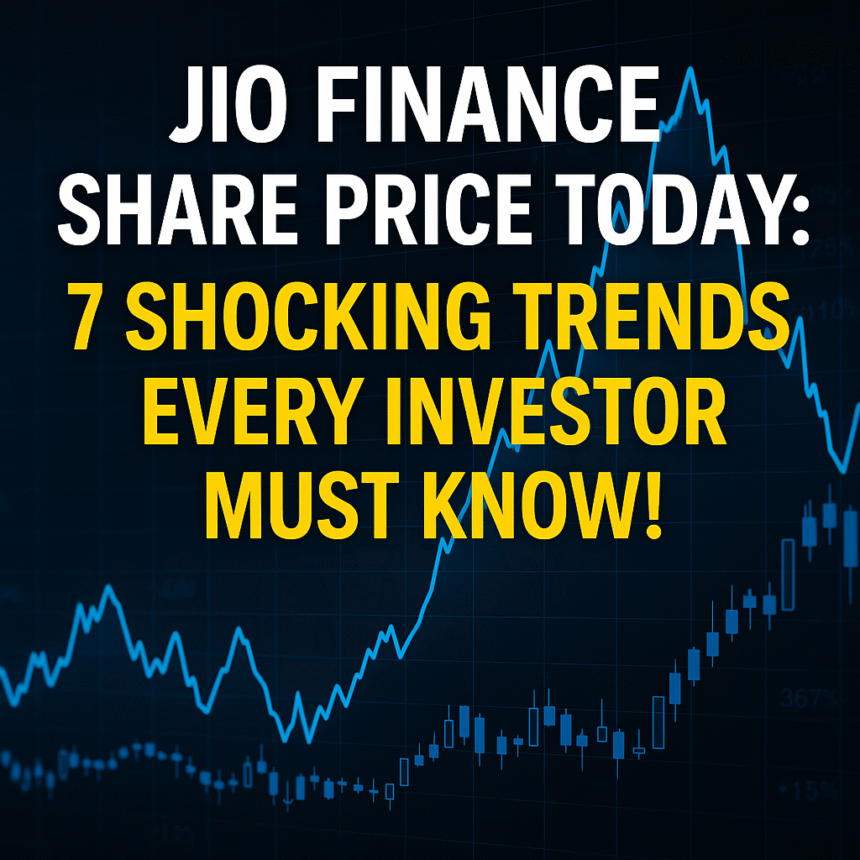Discover the latest Jio Finance share price, uncover 7 surprising trends driving investor sentiment, and gain strategic insights to make smarter investment decisions today.
1. Real‑Time Share Price & Recent Performance
As of the latest close, Jio Finance (Jio Financial Services) shares were trading around ₹294, down about 0.6% from the previous session’s ₹296 per share .
- Day range: ₹287.80 – ₹295.30
- 52‑week range: ₹198.65 (low) → ₹368.30 (high)
Interpretation:
The stock’s recent dip suggests a short‑term pullback. But with broader recovery in the past month (+10%) and Q1 (+32%), momentum still supports medium‑term bullishness .
2. Trend #1 – Market Volatility & Technical Patterns
Technical signals show mixed indicators:
- 10‑day moving average crossover triggered a “sell” signal on June 13, historically followed by a ~ 3% drop over the next week .
- Daily MACD crossover also flashed a bearish signal, with average 3.3% decline over 10 days in the past decade .
Takeaway:
While short‑term volatility and technical resistance persist, these indicators could present entry opportunities if fundamentals remain strong.
3. Trend #2 – Institutional Investor Movements
Holdings as of March 2025:
| Investor Type | Holding |
|---|---|
| Promoters | 47.12% |
| FIIs | 11.66% |
| DIIs | 14.16% |
| Mutual Funds | 6.58% |
| Others/retail | ~20.48% |
FIIs decreased their stake from 15.6% to 11.7%, while local institutions and retail interest increased slightly .
Impact:
FII profit‑booking could add pressure. But rising domestic and retail ownership may stabilize the stock, especially if BlackRock’s entry triggers positive sentiment.
4. Trend #3 – Jio–BlackRock JV Boost
Jio’s joint ventures with BlackRock—as an AMC and investment adviser—are transforming the narrative:
- SEBI formally approved Jio BlackRock as both investment adviser (June 11) and asset manager (May) .
- Share price rose ~3.5% on June 9 when the AMC leadership team was unveiled .
- Stock reaction was muted (down 0.05%) on June 11 news of JV license, suggesting mixed investor sentiment — perhaps awaiting product rollout .
Big picture:
BlackRock brings global credibility, tech (like Aladdin platform), and distribution heft. The JV’s rollout could steadily unlock value — especially once mutual fund/investment products go live .
5. Trend #4 – Valuation vs. Sector Peers
| Metric | Jio Finance | Sector Avg |
|---|---|---|
| P/E (TTM) | ~115× | 20–30× |
| P/B ratio | ~1.5× | Comparable |
| Dividend Yield | ≈0.17% | Varying higher |
Implication:
Jio trades at a steep premium due to its growth potential and corporate pedigree. High P/E suggests high expectations—and vulnerability to any slowdown. A drop in valuation toward peers may offer a buying window.
6. Trend #5 – Fundamental Financial Metrics
Key FY25 stats:
- Revenue Q4 FY25: ₹518 Cr (+23.9% Y/Y)
- Net Profit Q4 FY25: ₹270 Cr
- EPS TTM: ₹2.54; ROE ~1.2%; ROCE ~1.5%
Debt & Margin picture:
– Virtually zero debt (D/E ≈ 0.03×)
– Employee costs ≈10.5% of operating income; interest expense <1%
Analysis:
Strong growth, low leverage, and improving margins form the foundation. However, ROE and profitability ratios remain subdued compared to mature financial peers. The BlackRock JV is expected to improve earning quality.
7. Trend #6 – Peer Comparison & Competitive Positioning
Peers include Bajaj Finserv, Aditya Birla Capital, Shriram Finance, and Cholamandalam:
- Dividend yields: Bajaj Finserv ~0.05%, Shriram ~1.5%
- Jio’s strengths: digital-first platform, strong backing by Reliance, low debt, and upcoming asset management capabilities.
Assessment:
Though valuation ratios are lofty, Jio’s platform strategy positions it as future-ready, with potential digital disruption advantages over traditional lenders or brokers.
8. Trend #7 – Future Catalysts & Risks
Catalysts:
- Product launches: Mutual funds and advisory platforms from JioBlackRock could generate fee income and justify valuation.
- Regulatory nods: Future approvals for broking, insurance, and lending may expand growth.
- Digital scale: JioFinance app’s digital expansion (loans, payments, insurance) improves customer acquisition efficiency.
Risks:
- Execution gap between JV announcements and revenue realization.
- Global headwinds affecting asset inflows and risk assets.
- Valuation correction if growth disappoints or broader markets fall.
9. How These Trends Affect You — Investor Takeaways
- Short‑term traders should watch technical indicators—sell signals may persist until buying triggers occur.
- Medium‑term investors may view dips (~₹290–₹300) as opportunities ahead of product rollouts.
- Long‑term investors focused on franchise-building may prefer scaling into as JV execution unfolds, but mindful of valuation and competition.
10. FAQs
Q1: What is the current Jio Finance share price?
A: It’s trading around ₹294 per share (June 13 close), down ~0.6% from the prior session .
Q2: Why did the share price dip recently?
A: Technical sell signals, FII profit-booking, and cautious reaction to JV news all contributed to the pullback .
Q3: How significant is the BlackRock JV?
A: Very. JV brings global know-how, tech capabilities (Aladdin), and fee income potential — core to transforming Jio into a financial powerhouse ﹣.
Q4: Is Jio Finance overvalued?
A: At ~115× P/E, it’s significantly above peers. It may be justified if growth and earnings from asset management accelerate, but downside exists if execution lags .
Q5: Can it outperform peers?
A: With zero debt, digital reach, and a marquee JV, Jio could leapfrog peers—if market fundamentals align. But risks include slow adoption and aggressive pricing.
Q6: Should I buy now?
A: If you believe in Jio’s long-term platform strategy and JV execution, accumulate on dips. Short-term traders may wait for post‑JV revenue confirmation.
Conclusion: Should You Act on These 7 Trends?
“Shocking trends” summarizes critical market signals, but not alarm bells. Technicals suggest caution in the short term. However, fundamentals, institutional re‑positioning, and a transformative JV with BlackRock shine for medium-to-long term disciplined investors.
If you’re confident in Jio’s fearsome digital moat, franchise support, and JV rollout, consider phased investment. If you’re focused on valuation conservatism and earnings visibility, wait for next quarter updates before escalating exposure.

